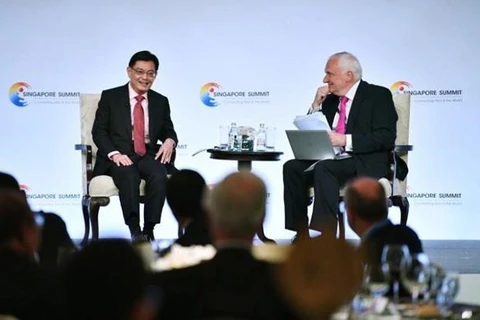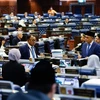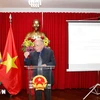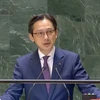Brussels (VNA) - As Singapore continues to see sluggish trade and growth data, with core inflation at a three-year low, economists forecast the central bank to ease monetary policy in its upcoming review and provide some support to the economy.
Many expects that the Monetary Authority of Singapore (MAS) to do so via a slight reduction in the Singaporean dollar (SDG) slope in order to boost demand for tradable goods and services.
MAS uses the exchange rate as its main monetary policy tool to balance between inflation from overseas and economic growth, and its next policy announcement is to be out no later than October 14.
The slight reduction implies an annual appreciation of around 0.5 percent for the Singaporean dollar, down from current estimates of a 1 percent annual appreciation.
Maybank Kim Eng economist Chua Hak Bin said that even though Singapore is likely to narrowly escape a technical recession, growth is still weak. This could come in at just around 0.2 percent for the third quarter, just slightly better than the 0.1 percent year-on-year expansion in the second quarter.
OCBC currency economist Terence Wu added that market focus has shifted from whether global central banks will cut rates to when and how deep rate cuts will be.
Barclays analysts Brian Tan, Ashish Agrawal and Abbas Keshvani added that the economy has clearly proven to be on shakier ground than MAS had assumed when it left foreign exchange policy settings unchanged last April.
They said with the outlook for US-China trade negotiations and Brexit shrouded in uncertainty, MAS will want to preserve the option to reduce the slope further in April.
Officials likely expect the economy to stabilise next year, they added./.
Many expects that the Monetary Authority of Singapore (MAS) to do so via a slight reduction in the Singaporean dollar (SDG) slope in order to boost demand for tradable goods and services.
MAS uses the exchange rate as its main monetary policy tool to balance between inflation from overseas and economic growth, and its next policy announcement is to be out no later than October 14.
The slight reduction implies an annual appreciation of around 0.5 percent for the Singaporean dollar, down from current estimates of a 1 percent annual appreciation.
Maybank Kim Eng economist Chua Hak Bin said that even though Singapore is likely to narrowly escape a technical recession, growth is still weak. This could come in at just around 0.2 percent for the third quarter, just slightly better than the 0.1 percent year-on-year expansion in the second quarter.
OCBC currency economist Terence Wu added that market focus has shifted from whether global central banks will cut rates to when and how deep rate cuts will be.
Barclays analysts Brian Tan, Ashish Agrawal and Abbas Keshvani added that the economy has clearly proven to be on shakier ground than MAS had assumed when it left foreign exchange policy settings unchanged last April.
They said with the outlook for US-China trade negotiations and Brexit shrouded in uncertainty, MAS will want to preserve the option to reduce the slope further in April.
Officials likely expect the economy to stabilise next year, they added./.
VNA

























